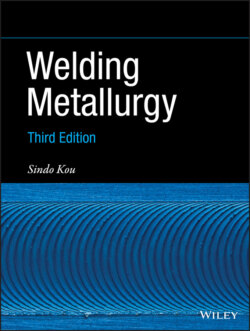Читать книгу Welding Metallurgy - Sindo Kou - Страница 94
3.3 Arc Power‐ and Current‐Density Distributions
ОглавлениеThis split‐anode method has been used to determine the power‐ and current‐density distributions in the arc at the anode surface [14–17]. A block of Cu with a flat top surface is split in half, so that a narrow gap exists between the two halves to electrically and thermally isolate them from each other. Water cooling prevents melting of the Cu anode, maintains the narrow gap, and also allows the heat transfer to each half to be determined from the water temperature rise. The anode is moved slowly under the arc horizontally in the direction normal to the gap, while the current and heat conducted to each half are constantly measured. Obviously, the split Cu anode differs from the real anode in GTAW because there is no metal evaporating from the water‐cooled Cu.
Figure 3.13 shows such distributions for a 100 A, 2.7 mm long gas–tungsten arc measured by Lu and Kou [17] using the split‐anode method. These distributions are often approximated by the following Gaussian distributions:
(3.1)
(3.2)
where q is the power density, Q the power transfer to the workpiece, a is the effective radius of the power‐density distribution, j is the current density, I the welding current and b the effective radius of the current‐density distribution. The effective radius represents the location where q or j drops to 5% of its maximum value. Equation (3.1) is identical to Eq. (2.12). Lee and Na [6] measured and calculated the power‐ and current‐density distributions in GTAW arcs. Figure 3.14 shows that the power‐ and current‐density distributions flatten and widen as the arc length increases.
Figure 3.13 Gas–tungsten welding arc: (a) power‐density distribution; (b) current‐density distribution.
Source: From Lu and Kou [17]. Welding Journal, February 1988, © American Welding Society.
Figure 3.14 Effect of arc length on gas‐tungsten welding arcs: (a) power‐density distributions; (b) current‐density distributions.
Source: Lee and Na [6]. Welding Journal, September 1996, © American Welding Society.
The power‐ and current‐density distributions measured by the split‐anode method (Figures 3.13 and 3.14) do not show the effect of metal vapor in the arc. The vapor can flatten the distributions, because it can increase the electrical conductivity of the cooler outer portion of the arc (Figure 3.8), and hence reduce the weld depth.
